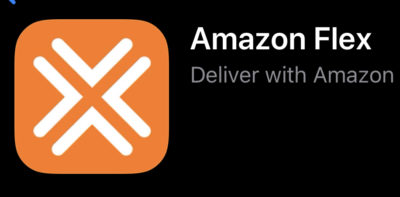How much can you make driving for Amazon Flex?
First of all, Amazon Flex Driving is a Gig Job, where you work as an independent contractor and pickup packages to deliver for Amazon. These could be boxes, ‘Prime’ (groceries and essentials), or Whole Food groceries.
I’m sure that pay rate could be market dependent, but my guess is that the concepts described here apply most places. The big take-away is YOU MAY NOT MAKE AS MUCH AS YOU THINK.

I have been driving for Amazon Flex for a few years, and I actually really enjoy it as it lets me get out and about and pays me some extra money. I would not want to depend on it as my main source of income as there is no guarantee that there will blocks available and you are totally at the mercy of Amazon and could be without a job tomorrow!
When I drive, I primarily drive the package deliver routes. Amazon calls this “Logistics.” And with those, I primarily only drive when I can get a surge rate for the delivery. The base rate (for my area?) is $18/hr and the max surge price is $23/hr. But, it is a bit harder to get surge pricing and you need to generally wait until very near the route departure time. I tend to pickup only 3 or 4 routes a week.
For this post, I wanted to work through some of the math to show what a delivery agent (Flex Driver) might actually be making, which leads to why I primarily only drive the “surge” priced routes.
Definitions and Concepts
- “Route”: When working as an Amazon Flex driver, you get work by picking up routes in the Amazon Flex app. A route will have a pickup location (Distribution Center, Whole Foods, etc), a pick-up time (4:15 PM), a duration (3.5 hours), and a dollar offer (what you’ll be paid for the route, $63 for example).
- Payments: Once you pick up a route, you will get paid the stated offer NO MATTER WHAT! It does not matter how long it takes. It does not matter how many stops. It does not matter how many miles you drive. It actually does not even matter if you actually deliver the goods (but if you don’t you will probably be released). Food deliveries will also include a tip that the customers can give you.
- Variability: There will be huge variability in the routes. Some will be super easy and quick. Some will be difficult and may even require returning packages which may add substantial time and miles. Generally, though, I find my actual delivery time for a 3-hour route will be 2 to 2.5 hours.
- “Surge”: The base rate for package routes is $18/hr. For food (Amazon Fresh and Whole Foods) it is $15 because you will also be getting tips (you hope). To entice people to pick up routes, Amazon will occasionally increase the base rate, but this seldom happens for food routes. The posted rate for a surge can and will bounce around. I have some ideas on why this happens, but in the end, I’m pretty sure it has to do with maximizing profits for Amazon. The max surge is $23/hr.
- “Net” vs “Gross”: The concept of net versus gross income is CRITICAL. Here is where Amazon is a bit of a bad actor (as I see it). They publish the $18/hr like you are going to be making that much, but in reality, you need to take your expenses out of this to have ANY IDEA about what you are actually making. Owning and driving a car COSTS REAL MONEY.
- Actual time for a route: In all my calculations, I include my driving time (and distance) from home to the pickup and from the last drop back home. In my mind, THIS IS KEY to understanding and evaluating the gig.
Choose to maximize $ (Payments) or $/hr (Rate)

There are lots of different choices about how you want to work with Amazon for selecting routes. What types of deliveries do you like? Which pickup locations are close to you? Where do the deliveries generally take you? What time of day works well for you and your schedule?
In terms of maximizing Payments or Rate, I find them to be pretty much opposites. For this posting, I’m primarily talking about how I maximize my RATE, how much do I make, and why I do it. I think there are many more drivers that try to maximize PAYMENTS. I understand that, but it is those people that might want to look closely at how much they are making.
There are lots of different choices about how you want to work with Amazon for selecting routes. What types of deliveries do you like? Which pickup locations are close to you? Where do the deliveries generally take you? What time of day works well for you and your schedule?
In terms of maximizing Payments or Rate, I find them to be pretty much opposites. For this posting, I’m primarily talking about how I maximize my RATE, how much do I make, and why I do it. I think there are many more drivers that try to maximize PAYMENTS. I understand that, but it is those people that might want to look closely at how much they are making.
My Data – Surge with Old Prius
Below is data from my routes in Summer 2020 where I selected surge price of $23/hr. This includes 24 routes over 3 months. As mentioned above, in calculating my mileage and hourly pay, I start from when I leave my house and end once I have returned. For these 24 routes, the average distance was 80 miles, and time was 3 hours and 12 minutes. And as mentioned, for each of these routes I was paid $69.

During this period, I was driving a 2009 Toyota Prius (one of the best cars for Gig Work!). I estimated my cost per mile to be only 20¢. Compared to the IRS which will pay 57¢/mile for an auto used for work purposes. You can see how I come up with this cost with my Cost Calculator and try your own car out!
For these routes, I averaged a NET $16.56/hour. I think this is respectable, but still MUCH LESS THAN the posted $23/hour.

The Data – At Base Rate
BUT WAIT, what if I took these routes at the base rate of $18/hour? So the data is the same except now rather than make a gross $69 (3 x $23) per route, I only get $54 (3 x $18) per route.
Now my Net goes down to $11.88/hour.

I try to drive a practical car for this job. The 2009 Prius is very gas efficient (43MPG), very reliable, and with 200k miles, it’s value is fully depreciated. I calculated to cost me $0.20/mi. Note that a newer less gas efficient car could cost you much closer to the IRS deduction rate of $0.57/mi.
The Data – Surge with IRS Auto Cost
LETS REDO the calculation, still with surge pricing of $23/hour, but use the IRS deduction rate of $0.57/mi. Now the NET rate goes down to $7.31/hour.

The Data – Base with IRS Auto Cost
AND FINALLY, let’s do the calculation with the Base rate of $18/hour and the IRS standard deduction of $0.57/mile. And we end up with only $2.63/hour!

Pretty sad…
